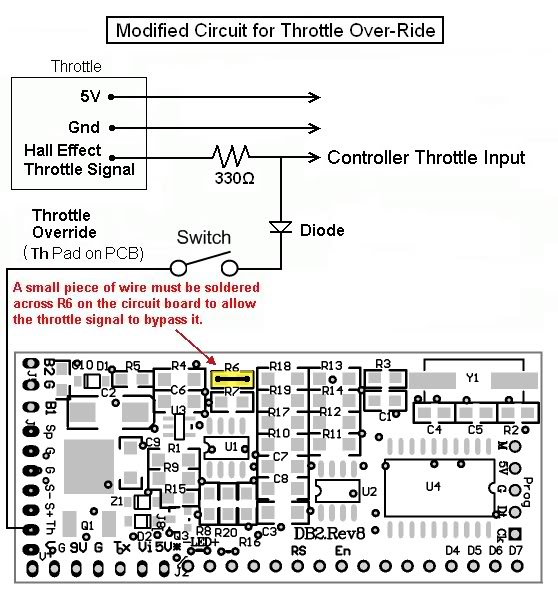Question is... How to set the system up... as for both motors to be on the Cycle Analyst... If, possible...Check out
Gary's video showing how to connect the two kits to a single set of controls.
As far as the Cycle Analyst is concerned, it should be possible to connect this to monitor the current draw of both motors if you are using a single battery or two batteries connected in parallel. If you are using a separate battery for each wheel, it will only be possible to monitor one of the motors.
Here is an updated diagram for the Cycle Analyst wiring details:

The switch is optional, but it enables the Cycle Analyst throttle override to be connected or disconnected to quickly swap between restricted speed/power and unrestricted speed/power.
The original solution to the Cycle Analyst problem can be seen
here.
Second question... How to set both motors to be on maximum torque for hill climbing... Speed does not matter...The Factory default setting for My MPIII controller was pre-set for maximum current
(maximum torque) so unless they are programmed differently nowadays, I presume this will still be the case with yours.
Third question... As the primary use, for the two motors... is to climb back up the very steep hill... at the end of the ride...
The battery will still be mostly fully charged... as we will be pedaling along the beach...during the ride...and not using the motors or battery much...My only concern here is the amount of residual drag produced by two motors
(which will require more pedal effort to overcome), you could find that you will need to use a bit of motor assistance to help overcome this drag if you're cycling along the beach at over 10mph.
The amount of assistance you use
(if any) will ultimately depend upon how energetic you and your rear passenger are feeling.
 The question... Will the (one) battery be able, to fully power both motors... for the short but steep climb...( 1 mile / 700 feet )
The question... Will the (one) battery be able, to fully power both motors... for the short but steep climb...( 1 mile / 700 feet )
Or will it take two batteries to fully power both motors for the climb... even if we are only talking about a 1 mile climb. on (one) full battery... or batteries...
I am hoping that the one battery can do the job... and just be drained twice as fast... while putting out maximum power, to meet maximum demand... for the two motors...As already mention by both L
ollandster and Pirontas, the combined current draw from both motors is probably going to be too much for a single battery (assuming you have opted the GM 48V 10Ah battery) and this could result in the motors cutting out under continual high load.
They don't appear to have a maximum continuous power output for the 10Ah packs stated on the GM site, but the 12Ah packs are only rated as 20 Amps continuous and 35 Amps Max. 
I suspect that the current rating of the BMS on the 10Ah pack will be pretty much the same as the 12Ah pack, but that's just a wild guess.
After watching Gary's dual drive torque test video I reckon that you could be pulling at least 55-60 Amps on parts of your steep climb home, but without knowing how quickly your going to climb the hill, it's difficult to estimate how much lower the average current draw will be.
Gary has come up with a solution to ensure he has enough Amps available to power his Dual Pie Machine:

Alan